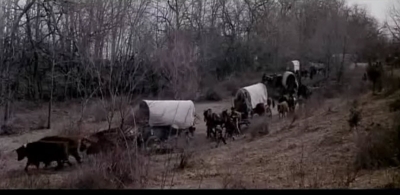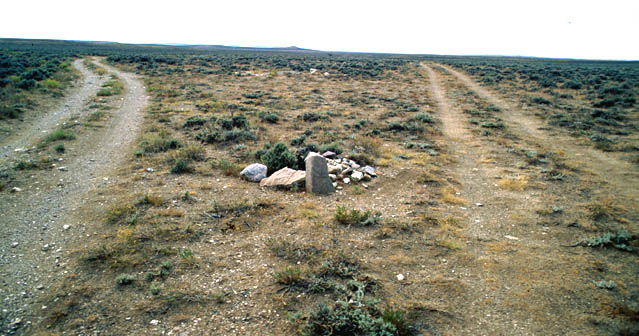Crossing the Plains to Salt Lake
An American Exodus
From 1846 to 1869, 70,000 Mormons traveled accross five states to escape religious persecution. While many think that the Mormon migration occurred in one swoop across the plains in 1847, in actuality, Mormons crossed the plains from various points over a twenty-three year span. The Pioneer Company of 1846-1847 established the first route from Nauvoo, Illinois, to Salt Lake City, Utah, covering 1,300 miles across five present day states. The last trail route used by ox wagons was from Benton, Wyoming, just east of present day Rawlins, Wyoming, to Salt Lake, a distance of about 300 miles.
Mormon Trail of 1846
The first section – 265 miles – tested the Mormons most severely. February that year in Iowa was marked by harsh weather and bitter cold. With 500 wagons, the Mormons grimly faced miles of axle-deep mud bogs and rough, obscure trails. Finally, by June 13, 1846, the first group of Mormons reached the Missouri River at Council Bluffs, Iowa. It had taken 120 days to cross 265 miles for an average of 2.25 miles a day. Some of these Mormons stayed in Council Bluffs, which was renamed Kanesville, while others crossed the Missouri and established Winter Quarters just North of present day Omaha on the Mississippi river. Brigham Young decided that the original plan to reach the Rockies by fall was now impossible. The Mormons would be staying on the Missouri until the following spring. Winter Quarters would prove to be a harsh stopping place during the winter of 1846-1847.
Mormon Trail of 1847
By the time the spring of 1847 approached in Winter Quarters, nearly 400 Mormon lives had been lost to various causes. On April 5, 1847, Brigham Young led the first Mormon wagon train out of Winter Quarters bound for Utah. 148 people, three of whom were women, 72 wagons, and a large collection of livestock made up this first group. For this first leg of the journey, the Mormons generally followed the Oregon Trail, also known as the Great Platte River Road. The well-beaten route took them along the Platte River through Nebraska, then along the North Platte River to Fort Caspar, then across Wyoming to Fort Bridger. At Fort Bridger on July 9, the Mormons left the Oregon Trail with 116 miles left to go. The previous year, the Reed-Donner party had blazed a route across Utah on their way to California. The Mormons took advantage of this route and followed it through the Wasatch Range and into Salt Lake. The people were filthy and weary and both wagons and livestock were weakened from the previous 1,000 miles of trail. The Wasatch Range proved to be a formidable barrier with its brush-choked canyons and steep passes. Finally, on July 24, 1847, the first group of Mormons arrived at their new home in the Great Salt Lake Valley.
Florence, Nebraska 1848 – 1964
Florence, Nebraska (Winter Quarters) is located just North and East of present day Omaha Nebraska on the banks of the Mississippi River. When wagon trains embarked on their journey west they generally followed the north side of the Platte River approximately 425 miles to Fort Laramie, where the pioneers crossed the river and joined the Oregon Trail. They generally traveled on the north side of the Platte River in order to avoid conflicts with their former Missourian enemies. They followed the Oregon Trail 397 miles to Fort Bridger, at which point they picked up the trail of the Donner-Reed party. They followed this faint trail into the Great Salt Lake Valley. These last 116 miles were the most treacherous thanks to steep mountains climbs and rocky ridges. This trail, which many Pioneers walked, was about 1,000 miles.
Wyoming Nebraska 1864 – 1867
In 1864 the jumping off point for heading to the valley of the Great Salt Lake moved from Florence, Nebraska, to Wyoming, Nebraska. Wyoming, Nebraska, a tent city which no longer exists, was located about 60 miles due south of Omaha. This was the next to last alteration for starting for the Mormon Trail head to the west. The change was made presumably due to native uprisings on the Oregon Trail and an outbreak of cholera at Florence. Wyoming was a small port town just a few miles north of present day Nebraska City, Nebraska. The Mormons set up a way station and settlement on a hill outside of Wyoming. Most immigrants took a train from New York City to St. Joseph, MO, at which point they would take a boat up stream to Wyoming, Nebraska. The immigrant companies consisted of Danish, Swiss, German, Dutch, French, Norwegian, Swedish, and English families. Wagons arrived each spring from Salt Lake City to pick up immigrant Saints and supplies. Between 1864 and 1867, approximately, 6500 immigrants departed from Wyoming destined for Salt Lake City, Utah. The trail from Wyoming generally followed the Nebraska City-Ft. Kearney Cut-off until reaching Fort Kearney, at which point the company rejoined the Mormon Trail on the north side of the Platte River. The Mormon outfitting station at Wyoming, Nebraska fell into disuse after 1867, when railroad expansion allowed immigrants to travel further west by train.
Wagons going to Oregon, California, and Utah shared the same trail until they reached the continental divide at South Pass Wyoming. The trip from Wyoming, Nebraska to Salt Lake City Utah was about 1,000 miles.
South Pass Wyoming is perhaps the most significant transportation-gateway through the Rocky Mountains. Indians, mountain men, Oregon Trail emigrants, Pony Express riders, and miners all recognized the value of this passageway straddling the Continental Divide. Bounded by the Wind River Range on the north and the Antilope Hills on the south, the pass offered overland travelers a broad, relatively level corridor between the Atlantic and Pacific watersheds.
At South Pass the trail separates and is called “The parting of the ways.” Parting of the Ways marked the point where parties headed to California and those headed to Oregon parted ways. In fact, if your destination was either California or Oregon, either branch would serve you well. Those in need of supplies or worried about the condition of their members or livestock usually took the left fork, towards Fort Bridger. Since this was also the only route to Utah, Mormon parties always took the road to the left. But California-bound emigrants could and often did travel with their Oregon-bound friends as far as the middle of Idaho. Nonetheless, Parting of the Ways did mark a spot where many emigrants bid a tearful farewell to friends they would probably never see again.
Parting of the Ways did mark a spot where many emigrants bid a tearful farewell to friends they would probably never see again.
Iowa City, Iowa 1856 -1860 – Handcart Pioneers
Mormon handcart pioneers were participants in the migration of members of the Latter-day Saints to Salt Lake City, Utah, who used handcarts to transport their belongings. Motivated to join their fellow Church members in Utah but lacking funds for full ox or horse teams, nearly 3,000 Mormon pioneers from England, Wales, Scotland and Scandinavia made the journey from Iowa or Nebraska to Utah in ten handcart companies. The trek was disastrous for two of the companies, which started their journey dangerously late and were caught by heavy snow and severe temperatures in central Wyoming. Despite a dramatic rescue effort, more than 210 of the 980 pioneers in these two companies died along the way. Although fewer than 10 percent of the 1846–68 Latter-day Saint emigrants made the journey west using handcarts, the handcart pioneers have become an important symbol in LDS culture, representing the faithfulness and sacrifice of the pioneer generation.
Benton, Wyoming 1868 – The last ox wagon trail route
About 250 emigrants, principally people from England and Scotland who crossed the Atlantic on the ship Emerald Isle, traveled in E. T. Mumford’s company. They traveled by train (in box and cattle cars) from New York to the wild and woolly end-of-track town of Benton, Wyoming (located 11 miles east of present-day Rawlins). This “Hell-on-Wheels” temporary town was inhabited by about 3,000 itinerant railroad workers, soldiers, saloon keepers, gamblers, and mule-whackers.There were twenty-five saloons and five dance halls. During its brief existence, reputedly over 100 souls met their maker in gunfights. Mumford waited there with his out-and-back teamsters for the arrival of the emigrants for nearly nine weeks. During that time several of the company’s livestock were stolen. When the emigrants arrived at the rail terminus, they loaded passengers, supplies, and luggage into a mule train of 28 wagons and started back to Utah on September 1, 1868. They traveled in a northwesterly direction from Benton through Whiskey Gap and northward from there until they reached the Sweetwater River and the old emigrant road. At this late date, they encountered head winds and cold nights. They entered the valley through Parley’s Canyon and reached Salt Lake on September 24. There were seven deaths in the company. The town in August and September 1868 provided the jumping off location for 2,000 Saints in 5 companies heading to Utah. The overall distance from Benton, Wyoming to Salt Lake was about 300 miles. The Golden Spike ceremony celebrating the completion of the transcontinental railroad was held on May 10, 1869 at Promontory, Utah. This ended and era, and from that point on, Immigrants could enjoy riding in the comfort of a train to cross the prairie.
Family Members who crossed the plains:
Florence, Nebraska – Hans Lorentz Dastrup Sr.
Florence, Nebraska – Ane Marie Andersen wife of Hans Lorentz Dastrup
Salt Lake City – Bernard Snow, Father of Minnie Snow (John) Dastup
Benton, Wyoming – Sarah Gledhill, Mother of Minnie Snow (John) Dastrup


/-91.3849,40.55,12/300x200@2x.png?access_token=pk.eyJ1IjoiamJlcmdlbiIsImEiOiJjanRxb3d1NWgwaHBuM3lvMzJ3emtyNWY4In0.xCCZGVjZrBAKn5C_O6q8CA)
/-111.891,40.7608,12/300x200@2x.png?access_token=pk.eyJ1IjoiamJlcmdlbiIsImEiOiJjanRxb3d1NWgwaHBuM3lvMzJ3emtyNWY4In0.xCCZGVjZrBAKn5C_O6q8CA)